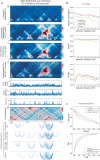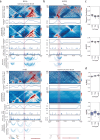ChromaFold predicts the 3D contact map from single-cell chromatin accessibility
- PMID: 39487131
- PMCID: PMC11530433
- DOI: 10.1038/s41467-024-53628-0
ChromaFold predicts the 3D contact map from single-cell chromatin accessibility
Erratum in
-
Author Correction: ChromaFold predicts the 3D contact map from single-cell chromatin accessibility.Nat Commun. 2025 Jan 15;16(1):684. doi: 10.1038/s41467-025-56017-3. Nat Commun. 2025. PMID: 39814735 Free PMC article. No abstract available.
Abstract
Identifying cell-type-specific 3D chromatin interactions between regulatory elements can help decipher gene regulation and interpret disease-associated non-coding variants. However, achieving this resolution with current 3D genomics technologies is often infeasible given limited input cell numbers. We therefore present ChromaFold, a deep learning model that predicts 3D contact maps, including regulatory interactions, from single-cell ATAC sequencing (scATAC-seq) data alone. ChromaFold uses pseudobulk chromatin accessibility, co-accessibility across metacells, and a CTCF motif track as inputs and employs a lightweight architecture to train on standard GPUs. Trained on paired scATAC-seq and Hi-C data in human samples, ChromaFold accurately predicts the 3D contact map and peak-level interactions across diverse human and mouse test cell types. Compared to leading contact map prediction models that use ATAC-seq and CTCF ChIP-seq, ChromaFold achieves state-of-the-art performance using only scATAC-seq. Finally, fine-tuning ChromaFold on paired scATAC-seq and Hi-C in a complex tissue enables deconvolution of chromatin interactions across cell subpopulations.
© 2024. The Author(s).
Conflict of interest statement
C.S.L. is an SAB member and co-inventor of IP with Episteme Prognostics, unrelated to the current study. M.G.K is a member of the scientific advisory board of 858 Therapeutics and the laboratory gets research support from AstraZeneca and Transition Bio. A.D.V. is an SAB member of Arima Genomics. A.Y.R. is an SAB member and has equity in Sonoma Biotherapeutics, Santa Ana Bio, RAPT Therapeutics, and Vedanta Biosciences. He is an SEB member of Amgen and BioInvent and is a co-inventor or has IP licensed to Takeda that is unrelated to the content of the present study. A.M.M. has research funding from Janssen, Epizyme, and Daiichi Sankyo. A.M.M. has consulted for Exo Therapeutics, Treeline Biosciences, and AstraZeneca. The remaining authors declare no competing interests.
Figures





Update of
-
ChromaFold predicts the 3D contact map from single-cell chromatin accessibility.bioRxiv [Preprint]. 2023 Jul 28:2023.07.27.550836. doi: 10.1101/2023.07.27.550836. bioRxiv. 2023. Update in: Nat Commun. 2024 Nov 1;15(1):9432. doi: 10.1038/s41467-024-53628-0. PMID: 37546906 Free PMC article. Updated. Preprint.
References
-
- Krijger, P. H. L. & De Laat, W. Regulation of disease-associated gene expression in the 3D genome. Nat. Rev. Mol. cell Biol.17, 771–782 (2016). - PubMed
Publication types
MeSH terms
Substances
Associated data
- Actions
- Actions
- Actions
- Actions
- Actions
- Actions
Grants and funding
- R00 CA246080/CA/NCI NIH HHS/United States
- P30 CA008748/CA/NCI NIH HHS/United States
- U01 HG012051/HG/NHGRI NIH HHS/United States
- HG012103/U.S. Department of Health & Human Services | National Institutes of Health (NIH)
- R01 CA283578/CA/NCI NIH HHS/United States
- K99 DK128602/DK/NIDDK NIH HHS/United States
- R01 CA225231/CA/NCI NIH HHS/United States
- DK128852/U.S. Department of Health & Human Services | National Institutes of Health (NIH)
- R01 CA270245/CA/NCI NIH HHS/United States
- R01 CA274249/CA/NCI NIH HHS/United States
- R01 CA186702/CA/NCI NIH HHS/United States
- R01 DK101989/DK/NIDDK NIH HHS/United States
- U01 HG012103/HG/NHGRI NIH HHS/United States
- R01 HL135564/HL/NHLBI NIH HHS/United States
- R01 CA193842/CA/NCI NIH HHS/United States
- U01 DK128852/DK/NIDDK NIH HHS/United States
LinkOut - more resources
Full Text Sources

